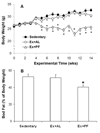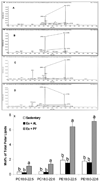Weight Loss via exercise with controlled dietary intake may affect phospholipid profile for cancer prevention in murine skin tissues
- PMID: 20233900
- PMCID: PMC3081581
- DOI: 10.1158/1940-6207.CAPR-09-0021
Weight Loss via exercise with controlled dietary intake may affect phospholipid profile for cancer prevention in murine skin tissues
Abstract
Exercise has been linked to a reduced cancer risk in animal models. However, the underlying mechanisms are unclear. This study assessed the effect of exercise with dietary consideration on the phospholipid profile in 12-O-tetradecanoylphorbol-13-acetate (TPA)-induced mouse skin tissues. CD-1 mice were randomly assigned to one of the three groups: ad libitum-fed sedentary control; ad libitum-fed treadmill exercise at 13.4 m/min for 60 min/d, 5 d/wk (Ex+AL); and treadmill-exercised but pair-fed with the same amount as the control (Ex+PF). After 14 weeks, Ex+PF but not Ex+AL mice showed approximately 25% decrease in both body weight and body fat when compared with the controls. Of the total 338 phospholipids determined by electrospray ionization-tandem mass spectrometry, 57 were significantly changed, and 25 species could distinguish effects of exercise and diet treatments in a stepwise discriminant analysis. A 36% to 75% decrease of phosphatidylinositol (PI) levels in Ex+PF mice occurred along with a significant reduction of PI 3-kinase in TPA-induced skin epidermis, as measured by both Western blotting and immunohistochemistry. In addition, approximately 2-fold increase of the long-chain polyunsaturated fatty acids, docosahexaenoic and docosapentaenoic acids, in phosphatidylcholines, phosphatidylethanolamines, and lysophosphatidylethanolamines was observed in the Ex+PF group. Microarray analysis indicated that the expression of fatty acid elongase-1 increased. Taken together, these data indicate that exercise with controlled dietary intake, but not exercise alone, significantly reduced body weight and body fat as well as modified the phospholipid profile, which may contribute to cancer prevention by reducing TPA-induced PI 3-kinase and by enhancing omega-3 fatty acid elongation.
(c) 2010 AACR.
Conflict of interest statement
Figures






References
-
- Ogden CL, Carroll MD, Curtin LR, McDowell MA, Tabak CJ, Flegal KM. Prevalence of overweight and obesity in the United States, 1999–2004. JAMA. 2006;295:1549–1555. - PubMed
-
- Patel AV, Feigelson HS, Talbot JT, et al. The role of body weight in the relationship between physical activity and endometrial cancer: results from a large cohort of US women. Int J Cancer. 2008;123:1877–1882. - PubMed
-
- Inoue M, Yamamoto S, Kurahashi N, et al. Daily total physical activity level and total cancer risk in men and women: results from a large-scale population-based cohort study in Japan. Am J Epidemiol. 2008;168:391–403. - PubMed
-
- Courneya KS, Katzmarzyk PT, Bacon E. Physical activity and obesity in Canadian cancer survivors: population-based estimates from the 2005 Canadian Community Health Survey. Cancer. 2008;112:2475–2482. - PubMed
-
- Kritchevsky D, Klurfeld DM. Influence of caloric intake on experimental carcinogenesis: a review. Adv Exp Med Biol. 1986;206:55–68. - PubMed
Publication types
MeSH terms
Substances
Grants and funding
LinkOut - more resources
Full Text Sources
Medical
Research Materials
Miscellaneous

